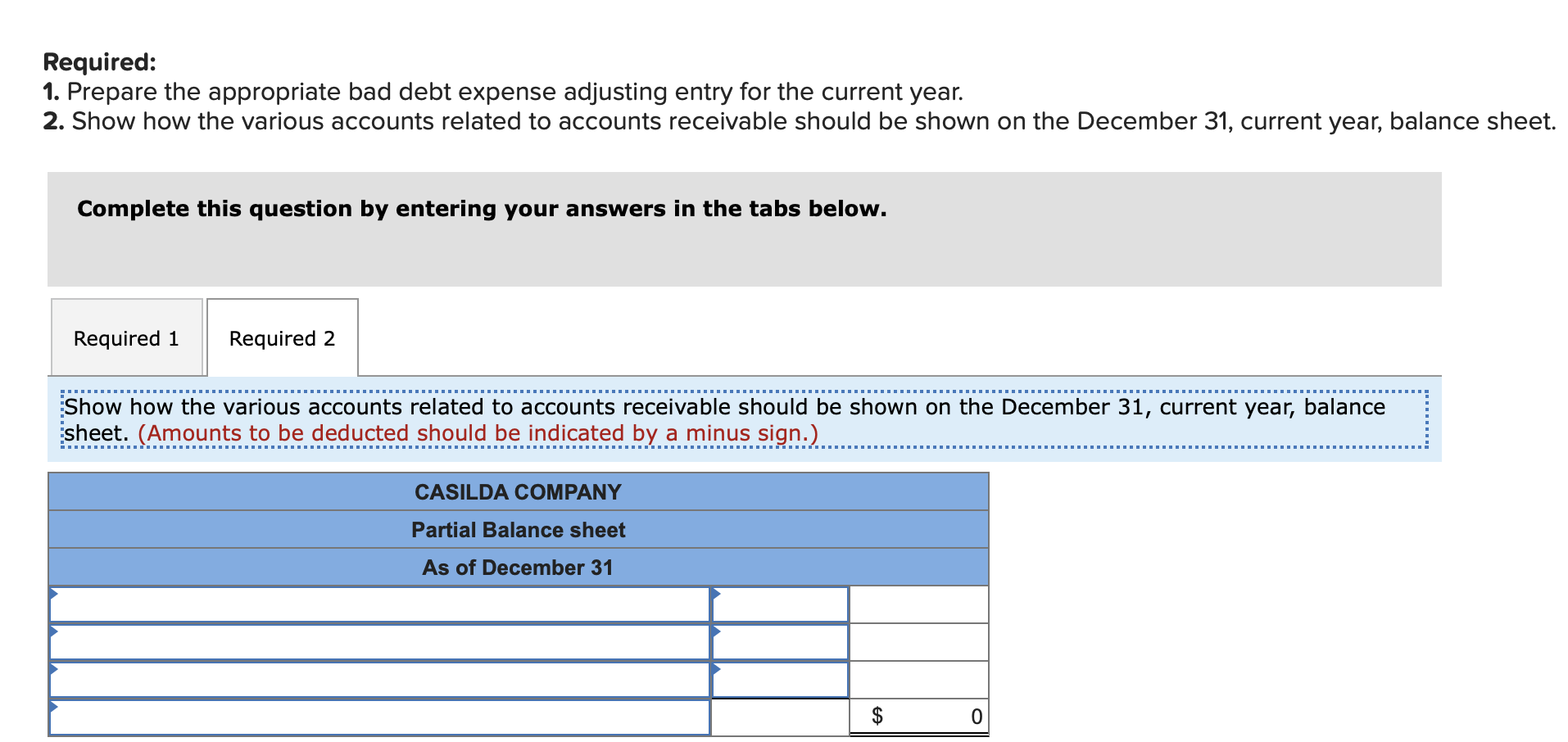Casilda Company uses the aging approach to estimate bad debt expense. The ending balance of each account receivable is aged on the basis of three time periods as follows: (1) not yet due, $50,100; (2) up to 180 days past due, $15,300; and (3) more than 180 days past due, $4,500. Experience has shown that for each age group, the average loss rate on the amount of the receivables at year-end due to uncollectibility is (1) 4 percent, (2) 12 percent, and (3) 30 percent, respectively. At December 31, the end of the current year, the Allowance for Doubtful Accounts balance is $400 (credit) before the end-of-period adjusting entry is made. Required: 1. Prepare the appropriate bad debt expense adjusting entry for the current year. 2. Show how the various accounts related to accounts receivable should be shown on the December 31, current year, balance sheet Complete this question by entering your answers in the tabs below. Required: 1. Prepare the appropriate bad debt expense adjusting entry for the current year. 2. Show how the various accounts related to accounts receivable should be shown on the December 31, current year, balance sheet Complete this question by entering your answers in the tabs below. Required 1 Required 2 Show how the various accounts related to accounts receivable should be shown on the December 31, current year, balance sheet. (Amounts to be deducted should be indicated by a minus sign.) CASILDA COMPANY Partial Balance sheet As of December 31 $ 0
Casilda Company uses the aging approach to estimate bad debt expense. The ending balance of each account receivable is aged on the basis of three time periods as follows: (1) not yet due, $50,100; (2) up to 180 days past due, $15,300; and (3) more than 180 days past due, $4,500. Experience has shown that for each age group, the average loss rate on the amount of the receivables at year-end due to uncollectibility is (1) 4 percent, (2) 12 percent, and (3) 30 percent, respectively. At December 31, the end of the current year, the Allowance for Doubtful Accounts balance is $400 (credit) before the end-of-period adjusting entry is made. Required: 1. Prepare the appropriate bad debt expense adjusting entry for the current year. 2. Show how the various accounts related to accounts receivable should be shown on the December 31, current year, balance sheet Complete this question by entering your answers in the tabs below. Required: 1. Prepare the appropriate bad debt expense adjusting entry for the current year. 2. Show how the various accounts related to accounts receivable should be shown on the December 31, current year, balance sheet Complete this question by entering your answers in the tabs below. Required 1 Required 2 Show how the various accounts related to accounts receivable should be shown on the December 31, current year, balance sheet. (Amounts to be deducted should be indicated by a minus sign.) CASILDA COMPANY Partial Balance sheet As of December 31 $ 0
College Accounting, Chapters 1-27
23rd Edition
ISBN:9781337794756
Author:HEINTZ, James A.
Publisher:HEINTZ, James A.
Chapter16: Accounting For Accounts Receivable
Section: Chapter Questions
Problem 3CP: At the end of 20-3, Martel Co. had 410,000 in Accounts Receivable and a credit balance of 300 in...
Related questions
Question
question 2

Transcribed Image Text:Casilda Company uses the aging approach to estimate bad debt expense. The ending balance of each account receivable is aged on
the basis of three time periods as follows: (1) not yet due, $50,100; (2) up to 180 days past due, $15,300; and (3) more than 180 days
past due, $4,500. Experience has shown that for each age group, the average loss rate on the amount of the receivables at year-end
due to uncollectibility is (1) 4 percent, (2) 12 percent, and (3) 30 percent, respectively. At December 31, the end of the current year, the
Allowance for Doubtful Accounts balance is $400 (credit) before the end-of-period adjusting entry is made.
Required:
1. Prepare the appropriate bad debt expense adjusting entry for the current year.
2. Show how the various accounts related to accounts receivable should be shown on the December 31, current year, balance sheet
Complete this question by entering your answers in the tabs below.

Transcribed Image Text:Required:
1. Prepare the appropriate bad debt expense adjusting entry for the current year.
2. Show how the various accounts related to accounts receivable should be shown on the December 31, current year, balance sheet
Complete this question by entering your answers in the tabs below.
Required 1
Required 2
Show how the various accounts related to accounts receivable should be shown on the December 31, current year, balance
sheet. (Amounts to be deducted should be indicated by a minus sign.)
CASILDA COMPANY
Partial Balance sheet
As of December 31
$
0
Expert Solution
This question has been solved!
Explore an expertly crafted, step-by-step solution for a thorough understanding of key concepts.
This is a popular solution!
Trending now
This is a popular solution!
Step by step
Solved in 4 steps with 4 images

Knowledge Booster
Learn more about
Need a deep-dive on the concept behind this application? Look no further. Learn more about this topic, accounting and related others by exploring similar questions and additional content below.Recommended textbooks for you

College Accounting, Chapters 1-27
Accounting
ISBN:
9781337794756
Author:
HEINTZ, James A.
Publisher:
Cengage Learning,

Cornerstones of Financial Accounting
Accounting
ISBN:
9781337690881
Author:
Jay Rich, Jeff Jones
Publisher:
Cengage Learning

Principles of Accounting Volume 1
Accounting
ISBN:
9781947172685
Author:
OpenStax
Publisher:
OpenStax College

College Accounting, Chapters 1-27
Accounting
ISBN:
9781337794756
Author:
HEINTZ, James A.
Publisher:
Cengage Learning,

Cornerstones of Financial Accounting
Accounting
ISBN:
9781337690881
Author:
Jay Rich, Jeff Jones
Publisher:
Cengage Learning

Principles of Accounting Volume 1
Accounting
ISBN:
9781947172685
Author:
OpenStax
Publisher:
OpenStax College


Financial And Managerial Accounting
Accounting
ISBN:
9781337902663
Author:
WARREN, Carl S.
Publisher:
Cengage Learning,